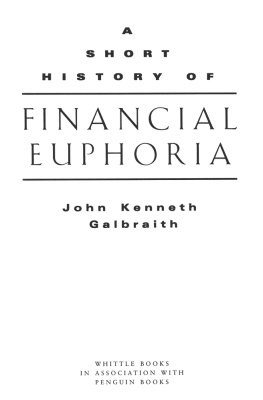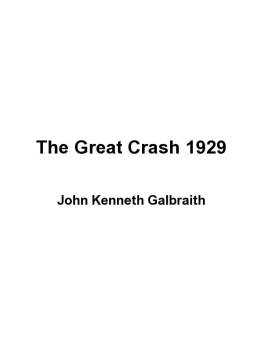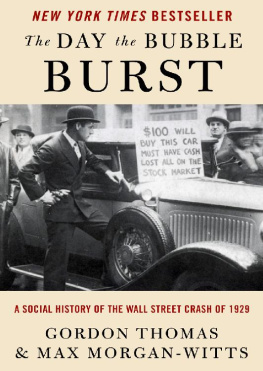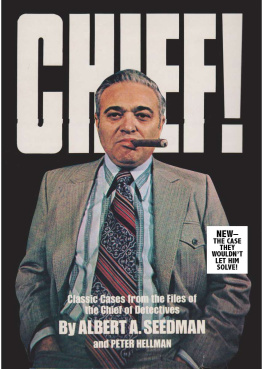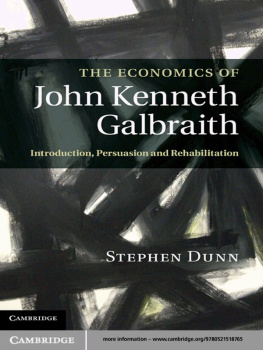PENGUIN BOOKS
A SHORT HISTORY OF
FINANCIAL EUPHORIA
John Kenneth Galbraith was born in 1908 in Ontario, Canada. He earned a PhD at the University of California in 1934 and later took a fellowship at Cambridge, where he first encountered Keynesian economics. At different points in his life he taught at both Harvard and Princeton, and wrote more than forty books on an array of economic topics. During World War II he served as deputy head of the Office of Price Administration, charged with preventing inflation from crippling the war efforts, and also served as the US Ambassador to India during the Kennedy administration. He passed away in 2006.


A
S H O R T
H I S T O R Y O F

FINANCIAL
EUPHORIA

J o h n K e n n e t h
G a l b r a i t h
WHITTLE BOOKS
IN ASSOCIATION WITH
PENGUIN BOOKS

PENGUIN BOOKS
Published by the Penguin Group
Penguin Group (USA) Inc., 375 Hudson Street, New York, New York 10014, U.S.A.
Penguin Group (Canada), 90 Eglinton Avenue East, Suite 700, Toronto,
Ontario, Canada M4P 2Y3 (a division of Pearson Penguin Canada Inc.)
Penguin Books Ltd, 80 Strand, London WC2R 0RL, England
Penguin Ireland, 25 St Stephens Green, Dublin 2, Ireland (a division of Penguin Books Ltd)
Penguin Group (Australia), 250 Camberwell Road, Camberwell,
Victoria 3124, Australia (a division of Pearson Australia Group Pty Ltd)
Penguin Books India Pvt Ltd, 11 Community Centre, Panchsheel Park, New Delhi - 110 017, India
Penguin Group (NZ), cnr Airborne and Rosedale Roads,
Albany, Auckland 1310, New Zealand (a division of Pearson New Zealand Ltd)
Penguin Books (South Africa) (Pty) Ltd, 24 Sturdee Avenue,
Rosebank, Johannesburg 2196, South Africa
Penguin Books Ltd, Registered Offices: 80 Strand, London WC2R 0RL, England
Published in the United States of America by
Viking Penguin, a division of Penguin Books USA Inc., 1993
Published in Penguin Books 1994
Copyright John Kenneth Galbraith, 1990
All rights reserved
This book was first published by Whittle Books as part of the Larger Agenda Series. Reprinted by arrangement with Whittle Communications L.P.
Photographs: Paul M. Warburg, Brown Brothers, .
Illustrations: Holland tulips, courtesy of W. Graham Arader III, Chicago, .
THE LIBRARY OF CONGRESS HAS CATALOGUED THE HARDCOVER AS FOLLOWS :
Galbraith, John Kenneth.
A short history of financial euphoria/John Kenneth Galbraith.
p. cm.
Includes bibliographical references.
ISBN: 978-1-101-65080-6
1. SpeculationCase studies. I. Title.
HG4528.G35 1993 332.645dc20 92-50765
Designed by Kathryn Parise
Except in the United States of America, this book is sold subject to the condition that it shall not, by way of trade or otherwise, be lent, re-sold, hired out, or otherwise circulated without the publishers prior consent in any form of binding or cover other than that in which it is published and without a similar condition including this condition being imposed on the subsequent purchaser.
F O R E W O R D

TO THE 1993 EDITION
It is now three years since I did the main work on this small book. As I told in the Foreword to the earlier edition, it concerns matters that have interested me for a third of a century and more. I first dealt with them in The Great Crash, 1929, published a little after the twenty-fifth anniversary of the 1929 debacle. That book has been continuously available ever since. Whenever it was about to pass out of print, some new speculative episode or disaster would bring it back to public attention. Over a lifetime I have been, in a modest way, a steady beneficiary of the speculative aberration in its association with more than occasional insanity. Only a stalwart character keeps me from welcoming these events as proof of personal prescience and as a source of small financial reward.
I n the first Foreword to this volume, I told of my hope that business executives, the inhabitants of the financial world and the citizens of speculative mood, tendency or temptation might be reminded of the way that not only fools but quite a lot of other people are recurrently separated from their money in the moment of speculative euphoria. I am less certain than when I then wrote of the social and personal value of such a warning. Recurrent speculative insanity and the associated financial deprivation and larger devastation are, I am persuaded, inherent in the system. Perhaps it is better that this be recognized and accepted.
I n the years since I wrote this short disquisition, the main players in the most recent speculative episode, that of the extravagant eighties, have met their all but inevitable fate, and the larger economic consequences have been made strongly and sadly evident. The list of those who have descended abruptly from the heights is long, and only a few need be mentioned. Mr. Michael Milken, perhaps the most spectacular figure of the last boom and certainly the best paid, is a recent resident in a minimum-security gaol, which, if not wholly uncomfortable, could not have seemed personally rewarding. One supposes that he met each new day without enthusiasm. Mr. Donald Trump is said not to be broke; he was, however, described in recent news accounts as having a negative net worth. These distinctions are no doubt important in the world of finance. The Reichman brothers, with Robert Campeau the Canadian gift to financial excess, are indubitably broke with depressive effect on the banks that were captured by their euphoric mood. Perhaps it is to their credit that, like Donald Trump, they erected monuments that will long commemorate their adventure. In London, tourists going down the Thames to the Tower will extend their journey to encompass the Canary Wharf development, perhaps the most awesome recent example of speculative dementia.
To a marked extent, the speculative orgy of the eighties was in real estate, including that financed through the S & Ls by the guaranteeing American taxpayer. Salomon Brothers of Wall Street recently estimated that it will be an average of twelve years before presently empty commercial real estate will be absorbed. Alas for averages. They think it will be an estimated twenty-six years in Boston, forty-six years in New York and fifty-six years down in San Antonio, Texas (the leader, so to speak), in this provision for the future.
However, the effects of the splurge extend far beyond real estate and range from the serious to the sad. New Yorkers can hardly escape a tear when they see the efforts of R. H. Macy, one of their great civic symbols, to stay alive and pay for the goods it sells and the pressing charges of those who supervise it in bankruptcy. The cause of the difficulties of this great institution are not in doubt: it was the heavy load of debt incurred in the effort to obtain and retain control during the years of financial pillage and devastation. Across the country other enterprises were similarly afflicted and are similarly oppressed with the resulting debt. Oppressed with them are the banks that sustained the real estate speculation and provided credit for the mergers and acquisitions, hostile takeovers and leveraged buyouts, and the other exercises in financial devastation.

